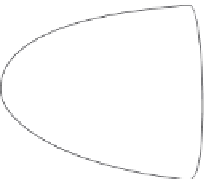Environmental Engineering Reference
In-Depth Information
With these turbines, the wind fl ows from the front towards the rotor hub. Due to
the relatively fast-rotating rotor blades, there is an airstream in addition to the actual
wind and this airstream fl ows from the side onto the rotor blade (Figure 8.6). The
rotor blade is then struck by a resulting wind that is composed of both the actual
wind and the airstream.
Figure 8.6
Functioning
principle of a wind turbine with
a horizontal axle.
The rotor blade now divides the wind. The resulting wind fl ows along the rotor
blade. Due to the shape of the rotor blade, the wind has a longer distance to cover
on the upper surface of the blade than on the lower surface. As a result, the fl ow
widens and the air pressure decreases. Low pressure is created on the upper surface
and high pressure is created on the lower surface. This difference in pressure then
produces a lift force that reacts vertically to the resulting wind.
This lift force can be split into two components: the thrust force in the direction of
the rotor axle and the tangential force in the direction of the circumference.
Unfortunately, in most cases the thrust force is bigger than the tangential force. The
thrust force is not very useful. It merely presses against the rotor blades and bends
them. The construction of the rotor blades themselves must therefore be very stable
so that they can resist the thrust power. Ultimately, the tangential force is responsible
for the rotation of the rotors because it works along the circumference.
Modern wind turbines always try to optimize the volume of tangential force. This
requires an optimal relationship between the actual wind velocity and the airstream.
The rotation of the rotor affects the airstream. The rotation of the rotor blades
enables an optimization of the angle at which the resulting wind approaches the
blade. This deliberate rotation of the rotor blade is known as 'pitching'.











































